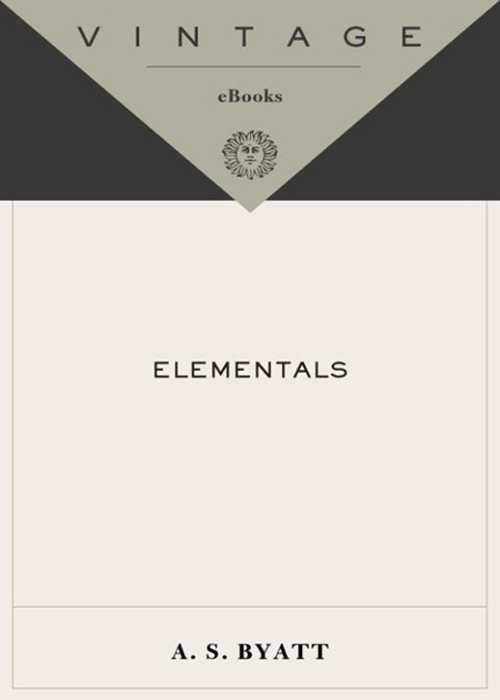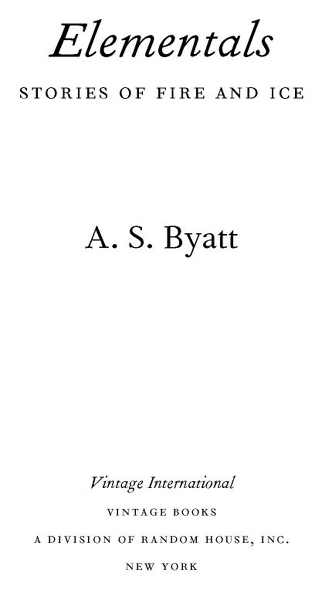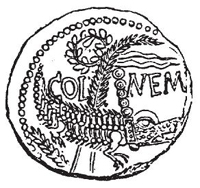Authors: A.S. Byatt
Elementals


Table of Contents
For Claus Bech
ACCLAIM FOR A. S. BYATT’S
Elementals
“[Byatt’s] prose has a lustrous yet exacting shimmer that answers to Keats’s injunction that poetic language should ‘surprise by a fine excess.’”
—The Boston Globe
“Energetic and magisterial . . . full of light and life.”
—The New York Times Book Review
“Sparkling. . . . [Byatt’s] vivid prose leaps and pirouettes, shimmies and shivers.”
—The Wall Street Journal
“Harnesses a brilliant new power. . . . Byatt has reached back to legend and fairy tale, elements of storytelling as basic and combustive as fire and ice.”
—Los Angeles Times Book Review
“A collection of richly imagined stories etched in such vivid color, sensuousness, and language that they seem like art objects. . . . A delight.”
—Richmond Times-Dispatch
Acknowledgements
I am grateful to my Norwegian editor, Birgit Bjerck, for telling me about the one tree, and for information about
Peer
Gynt.
I am also grateful to David Perry for commissioning the ekphrastic tale about Velasquez. My husband, Peter, gave me a central idea about Jael, and Helen Langdon found several images of Jael that were most illuminating. I am, as always, grateful to Jenny Uglow, best of readers, for patience and inspiration. And also, as always, to Gill Marsden for order out of chaos.
The author and publishers are grateful for permission to reproduce the following illustrations:
Nîmes crocodile: from The Crocodile of Nîmes by W. Froehner, Paris, 1872;
Sirène
by Henri Matisse: from Ronsard’s
Florilège des Amours
. Collection Musée Matisse. © Succession H. Matisse/DACS 1999;
Façon de Venise
goblet: © Sotheby’s Picture Library;
Jael and Sisera
, School of Rembrandt: Kent County Council, from the Kent Master Collection; detail from
Kitchen Scene with Christ in the House
of Martha and Mary
by Velázquez: © National Gallery, London.
Crocodile Tears

Le Crocodile de Nîmes
Crocodile Tears
Patches of time can be recalled under hypnosis. Not only suppressed terrors but those flickering frames of the continuum that, even at the time, seem certain to be forgotten, pleasantly doomed to nonentity. So they have sunk into our brains after all, are part of us. Patches of time is a mild metaphor, mixing time and space, mildly appropriate in art galleries, where time is difficult to deal with. How do you decide when to stop looking at something? It is not like a book, page after page, page after page, end. You give it your attention, or you don’t. The Nimmos spent their Sundays in those art galleries that had the common sense to open on that dead day. Not the great state galleries, but little ones, where some bright object or image might be collected. They liked buying things, they liked simply looking, they were happily married and harmonious in their stares, on the whole. They engaged a patch of paint and abandoned it, usually simultaneously, they lingered in the same places, considering the same things. Some they remembered, some they forgot, some they carried away to keep.
That Sunday, they were in the Narrow House Gallery, which specialised in minor English art, drawings, prints of flowers, birds, angels, hand-screen landscapes and pop art posters. It was higgledy-piggledy, with real plums in the duff, Tony Nimmo used to say. The Gallery was in Bloomsbury, in what had been an eighteenth-century private house; it went up and up, with small rooms opening off a turning stair, which was also hung with stags and sunsets, garden gates, watering cans and silver lakes with swans on. They always had a good pub lunch on these Sundays. This one was a sunny Sunday in early May, a really sunny Sunday that narrowed the eyes in the light, that warmed the skin, even through glass. Patricia ate prawn salad; she was watching her figure. Tony ate a robust beef and ham platter with pickles and onions. Then he had brandy syllabub. And two pints of Special. He was a large man, with a bald crown above fine dark hair. His face was peacefully reddened, a pale poppy flush. They were in their middle fifties. Patricia wore a butter-yellow suit, nipped in at the waist, and a bronze silk scarf. Her hair was bronze too, fanning up and out. She had good big breasts and a generous bottom, solid and lively. On the top floor of the Narrow House, they had one of their rare disagreements.
The disagreement was about a work called
The
Windbreak
. It was small; about two feet long and one foot deep, framed in a deep, polished dark wooden frame, with brass nails. It was part collage, part oil painting. It was a seaside scene, an English seaside scene, with a blue-grey sea, flecked with dirty white, stretching to meet a pewter sky with livid oily blue patches. These took up the top two-thirds of the work. The beach had real sand scattered on a fawn surface, and tiny real shells and bits of seaside plastic reconstituted into tiny windmills and buckets and spades, sugar-pink, turquoise-blue, poster-red. Much of the left part of the beach was taken up with the windbreak. This was made up of painted cloth, in rainbow stripes, stretched on wooden pegs, representing stakes. There was also a coloured ball, Day-Glo orange with green stars on it. Patricia’s indifferent glance slid over this object; she had seen, in other patches of time, hundreds more or less like it; she moved on to contemplate a delicate six-inch-square dandelion clock on a cobalt-blue ground. Tony, however, was taken with
The Windbreak
. He went up to it, and peered into its glass box. He stood back and stared. He smiled. Patricia, when he called her, turned back from the dandelion, and saw him smiling.
‘I like this,’ said Tony. ‘I really like this. It isn’t much.’
‘You can’t like that, darling. It’s banal.’
‘No, it’s not. I can see how you might think it was. But it’s not. It’s just simple and it reminds you of things, of whole – of whole – oh, of all those long days of doing nothing on beaches, you know, the mixture of misery and being out in the air and sort of free – of being a child.’
‘Banal, as I said.’
‘
Look
at it, Pat. It’s a perfectly good complete image of something important. And the colours are good – all the natural things dismal, all the man-made things shining – ’
‘Banal, banal.’ Patricia did not know why she was so irritable. It had been a good lunch. She could even, secretly, see what the memory-box would look like to her if she had liked it, as opposed to disliking it. Tony and the unknown artist shared an emotion, shared a response to the conventional images that evoked that emotion. She didn’t, or if she did, it provoked opposition.
‘I like it,’ said Tony. ‘I’ll buy it, it can go in my study, in that space by the window.’
‘It’s a complete waste of money. You’ll go off it in no time. I don’t want a thing like that in the house. Look at the dreadful predictability of those colours.’
‘Don’t be so snooty. It’s
about
the dreadful predictability of those colours. About sad English attempts to cheer up sad English landscapes.’
‘They don’t have to be sad. Not the English, not the colours, not the landscapes. It’s a dreadful cliché.’
‘Clichés are moving.’
‘I don’t want it.’
‘I do.’
‘I can’t stop you,’ said Patricia, walking away, past a green maze, past a departing galleon, past a hunt in full cry. She was upset; the good Sunday was threatened by Tony’s bad taste. She turned round to tell him that it didn’t really matter, that of course he should buy the windbreak if he wanted it, and found that she was alone in the upper room. She could hear his heavy tread winding down the stairwell. She would make it up later. Leave a space, make it up later. She turned back to the walls – a blown sheep on moorland, a huge black bull, staring furiously out of the canvas, a fragile bunch of teasels. Later all this would come back, without hypnosis.
It was perhaps half an hour before she went downstairs. She was wearing high-heeled sandals, so she went very carefully round the turns of the stairs, holding on to the banister. There was a noise downstairs, of doors, of voices; she could hear no words, but she could hear agitation. There were thuds, there was hurry. Outside, there was a siren. Cautiously, she turned the last corner. She saw the backs of a tight group of people bending over something at the bottom of the stairs. A man in a green sweater, who had been kneeling, stood up. He was holding a stethoscope. ‘Dead,’ he said. ‘I’m afraid. Instantly. A massive infarct, I suppose. No hope, I’m afraid.’ Outside, a stretcher was being carried in from an ambulance. The group split, and stood back, and Patricia saw Tony, lying on his back, on the carpet, below a large painting of an avalanche. His red face was ivory. The doctor had closed his eyes but he did not look peaceful. His jacket and shirt were opened; the grey hairs on his chest were springy. His belly was a proud mound. His shoes were splayed. Patricia stood by the banister. The ambulance-men came in with the stretcher. As the group gathered again, Patricia walked quickly behind them, and out of the open door, into the street. She walked away, quick, quick, with her head up. She stood beside the flowing traffic on New Oxford Street. A taxi came past with a gold light in a black frame. She waved, it stopped, she got in. She gave her home address, which was in Wimbledon. The driver said something, which she did not hear. She sat, clenching both fists on her handbag. It was quick.
Inside her own house she walked from room to room in the May light, and then went upstairs and packed a small suitcase. She was an efficient woman, and she packed for a business trip – a nightdress, cheque-books, the usual pharmacopoeia, uncrushable trousers and tunics, slippers. Washing things, make-up, lap-top, mobile phone. Universal adaptor. Passport. Then she looked round her bedroom, their bedroom, and left it. She called a taxi, and looked round the drawing-room. A few photographs smiled at her: Tony in tennis things on the bookshelf, the children twenty years ago. She turned these face down. The phone began to ring. She did not answer, and after a time, it stopped. Then it began again. The taxi came. She went out, leaving it ringing. In the taxi, she realised that she should have changed out of her sandals, and nearly burst into tears. She told the taxi-driver to go to Waterloo. At Waterloo she walked from the main station to the Eurostar terminal, covering her tracks perhaps, and bought a ticket to Paris. It was smooth, it was easy, there was a train in half an hour. She flowed with the crowd onto the platform, carrying her little bag, and at the top of the escalator, catching sight of her dim reflection in the train window, she nearly began to weep again because of the memorable brightness of her yellow suit.
She found some dark glasses in the pocket of her case, and leaned back in her seat, staring out at fields and hedges. She refused food, refused newspapers. She slept. She woke in the dark tunnel, in a swaying space, and for a moment did not know who or where she was, only that something had happened. Then she began to worry about money. How to have money without being traced? She had money, she was the founder and managing director of a chain of shops, Anadyomene, that specialised in bathrooms. The question was, how to have money where she was going, without being traced. She had thought about this before. Vanishing without trace was an idea that had teased her through all the happy years of her married life, her working life. The idea that it was possible to vanish, that there was nothing ineluctably necessary about her work, or her home, was a condition of her pleasure in those things.
She did not think, at this point, about who might trace her. She had a daughter, Megan, and a son, Benjamin, Ben, Benjie, both grown-up and married, but they were not the pursuers she figured to herself.
She did not know where she was going.
They brought champagne in little tub-like tumblers, and this she accepted. She felt a light-headed pleasure in the fact that she did not know where she was going. It could be anywhere at all, anywhere at all. How many people was that ever true of? The train came out of the tunnel.
She had booked to Paris, but she got out at Lille. She bought a ticket to Nice, and climbed into a TGV, going south. It was now evening. Lille station was darkening. She remembered early versions of the imagined escape. The young bride’s version, standing solitary on the heaving deck of the cross-Channel steamer, a vision complete with wake, spray, crying gulls, and the moving troughs on the surface of the salt deeps under which she had just shot, sitting in her dark glasses by her brightly lit window. The successful woman’s version, the rising nose of the aircraft breaking through the white froth of cloud into clear blue and sunlight, the space of creamy-curded water-vapour, the silver purr. Anywhere, at the end of it. Anywhere, nowhere, somewhere. The train was without shock. But quick. The darkening fields flung past, unreadable indicators hissed past, the sky went turquoise, Prussian blue, indigo, rusty black in the lights of the way. She slept. She dreamed, and when she woke, remembered that she had dreamed something she didn’t want to remember. Her mind ran loose and nauseous, for a moment, and then she began to worry about credit cards, about whether they could or would trace credit cards. The world was small now, which was good, you could move in it with ease. But everything was linked to every other thing, and that wasn’t good.
She got out at Avignon, several hours later, and took a train to Montpellier and Barcelona. Shortly after Avignon, the train stopped at Nîmes, and there she got out, it was perhaps the coincidence, the almost coincidence, of the names, Nîmes, Nimmo, that decided her. It wasn’t a city she knew anything about. No one would look for her there, for that reason. She set off, in the warm southern darkness, on the high-heeled sandals in which she had come down that staircase, carrying her bag. The city has big boulevards, with plane trees, and she kept to these, walking briskly, past cafés spilling light on to dark pavements, past squares, past alleys. She followed signs to ‘Jardin de la Fontaine’ because that sounded like a refuge, and thus found herself outside the Hôtel Impérator Concorde, which looked, and was, large and comfortable. She went in, and booked a room. The room was curtained and shuttered. There was a large bed, with a sprigged Provençal quilt, rose and gold on cream, to match the curtains, which she pulled back, revealing tall, sun-blistered shutters and a small balcony. She looked out; below was a walled garden, full of trees, cypresses and olives, and with a fountain bubbling in golden light in a pale green-blue pool. She closed the shutters again. She found she had a semicircular bath in tawny pink, tiled round with eighteenth-century birds in pink on white glaze. She bathed, and put on her nightdress. She put out the lights and got into the large bed. She remembered briefly, the windbreak and the painted avalanche, broken trees and dislodged rocks in the arrested crush of carefully painted snow. She thought she would move money, tomorrow, out of the Jersey account, and then move it again, and then move it again. The bed was like a nest, the pillows frilled, the sheets crisp. She was afraid of not sleeping, but slept. In the morning there were bright needle-stripes of light in the shutters. When she opened them, there was the blue sky, full of pale yellow light.
